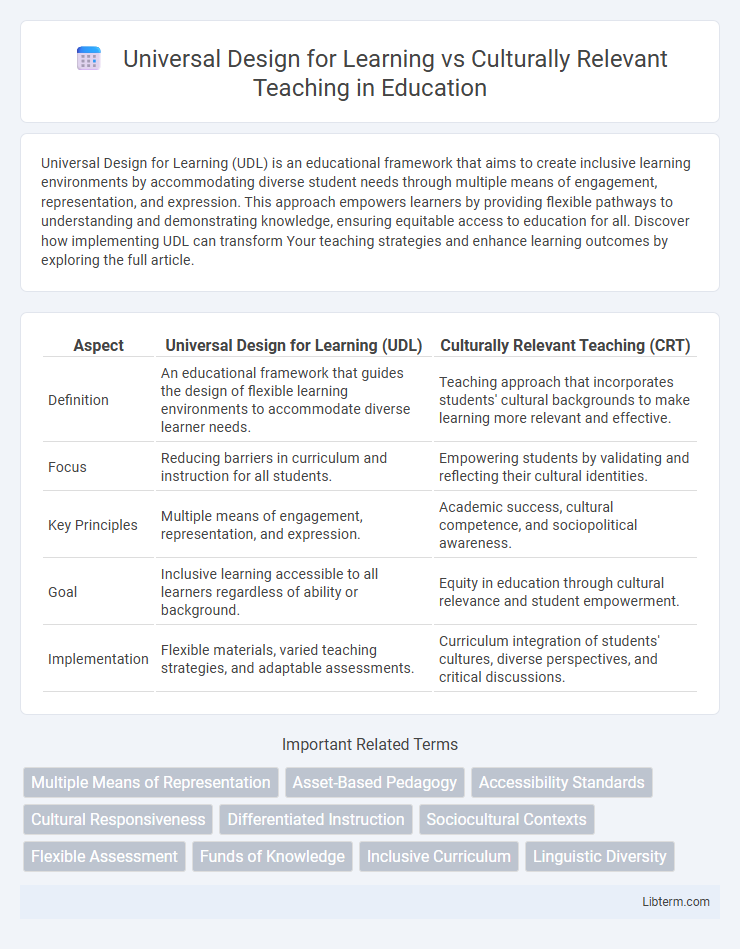Universal Design for Learning (UDL) is an educational framework that aims to create inclusive learning environments by accommodating diverse student needs through multiple means of engagement, representation, and expression. This approach empowers learners by providing flexible pathways to understanding and demonstrating knowledge, ensuring equitable access to education for all. Discover how implementing UDL can transform Your teaching strategies and enhance learning outcomes by exploring the full article.
Table of Comparison
| Aspect | Universal Design for Learning (UDL) | Culturally Relevant Teaching (CRT) |
|---|---|---|
| Definition | An educational framework that guides the design of flexible learning environments to accommodate diverse learner needs. | Teaching approach that incorporates students' cultural backgrounds to make learning more relevant and effective. |
| Focus | Reducing barriers in curriculum and instruction for all students. | Empowering students by validating and reflecting their cultural identities. |
| Key Principles | Multiple means of engagement, representation, and expression. | Academic success, cultural competence, and sociopolitical awareness. |
| Goal | Inclusive learning accessible to all learners regardless of ability or background. | Equity in education through cultural relevance and student empowerment. |
| Implementation | Flexible materials, varied teaching strategies, and adaptable assessments. | Curriculum integration of students' cultures, diverse perspectives, and critical discussions. |
Understanding Universal Design for Learning (UDL)
Universal Design for Learning (UDL) is an educational framework aimed at improving and optimizing teaching and learning for all people based on scientific insights into how humans learn. UDL emphasizes providing multiple means of engagement, representation, and action/expression to accommodate diverse learner needs and preferences. In contrast, Culturally Relevant Teaching focuses on incorporating students' cultural backgrounds into the curriculum to make learning more meaningful and effective.
Defining Culturally Relevant Teaching (CRT)
Culturally Relevant Teaching (CRT) is an educational framework that emphasizes the incorporation of students' cultural references in all aspects of learning to promote academic success, cultural competence, and critical consciousness. CRT focuses on validating and affirming diverse cultural backgrounds, enabling students to connect curriculum content with their own experiences and identities. This approach contrasts with Universal Design for Learning (UDL), which centers on creating flexible learning environments accommodating diverse learning needs without explicitly addressing cultural context.
Core Principles of UDL
Universal Design for Learning (UDL) centers on providing multiple means of engagement, representation, and action and expression to accommodate diverse learners. Culturally Relevant Teaching emphasizes connecting educational content to students' cultural backgrounds to enhance relevance and engagement. While UDL's core principles promote flexible learning environments accessible to all, Culturally Relevant Teaching specifically addresses cultural identity to foster meaningful learning experiences.
Key Elements of CRT
Culturally Relevant Teaching (CRT) centers on student-centric strategies that validate diverse cultural backgrounds, emphasizing three key elements: academic success, cultural competence, and critical consciousness. CRT fosters an inclusive classroom where students achieve academically while developing awareness of social inequalities and embracing their cultural identities. This approach contrasts with Universal Design for Learning (UDL), which provides flexible learning methods to accommodate all learners without specific emphasis on cultural contexts.
UDL vs CRT: Foundational Philosophies
Universal Design for Learning (UDL) emphasizes creating inclusive educational environments by providing multiple means of engagement, representation, and expression to accommodate diverse learning needs. Culturally Relevant Teaching (CRT) centers on incorporating students' cultural backgrounds and experiences into the curriculum to enhance academic success and identity affirmation. UDL is rooted in neuroscience and accessibility principles, while CRT is grounded in social justice and equity frameworks targeting systemic cultural responsiveness.
Addressing Diverse Learner Needs
Universal Design for Learning (UDL) employs flexible instructional strategies and multiple means of engagement, representation, and expression to accommodate diverse learner needs, ensuring accessibility for all students regardless of ability. Culturally Relevant Teaching (CRT) integrates students' cultural backgrounds, experiences, and perspectives into the curriculum to enhance relevance and foster academic success for marginalized groups. Both approaches prioritize inclusivity, but UDL emphasizes structural adaptability, while CRT centers on cultural responsiveness to address diverse learner needs effectively.
Curriculum Design: UDL and CRT Approaches
Universal Design for Learning (UDL) in curriculum design emphasizes flexible learning environments that accommodate diverse learning styles through multiple means of representation, engagement, and expression. Culturally Relevant Teaching (CRT) focuses on integrating students' cultural backgrounds into the curriculum, promoting academic success, cultural competence, and critical consciousness. Combining UDL's flexible framework with CRT's cultural responsiveness enhances inclusivity and relevance in curriculum design, addressing diverse learner needs and cultural contexts simultaneously.
Teacher Roles in UDL and CRT Frameworks
Teacher roles in Universal Design for Learning (UDL) emphasize designing flexible learning environments that accommodate diverse learner needs by providing multiple means of engagement, representation, and expression. In Culturally Relevant Teaching (CRT), teachers act as cultural mediators, integrating students' cultural backgrounds into the curriculum to promote academic success, cultural competence, and critical consciousness. Both frameworks position teachers as adaptive facilitators who tailor instruction to support inclusive and equitable learning experiences.
Benefits and Challenges of UDL and CRT
Universal Design for Learning (UDL) benefits include increased accessibility, personalized learning paths, and improved engagement for diverse learners, but challenges involve resource intensity and teacher training complexity. Culturally Relevant Teaching (CRT) enhances student identity affirmation, cultural competence, and academic achievement, while facing difficulties such as balancing cultural responsiveness with standardized curriculum and potential educator bias. Integrating UDL and CRT maximizes inclusivity and equity by addressing diverse learning needs and cultural contexts simultaneously.
Integrating UDL and CRT for Inclusive Classrooms
Integrating Universal Design for Learning (UDL) and Culturally Relevant Teaching (CRT) creates inclusive classrooms by addressing diverse learning needs and cultural backgrounds simultaneously. UDL's flexible frameworks promote accessible learning goals, materials, and assessments, while CRT ensures content reflects students' cultural identities, fostering engagement and relevance. Combining these approaches enhances equity by supporting all learners through adaptive pedagogy that values both diversity and accessibility.
Universal Design for Learning Infographic

 libterm.com
libterm.com